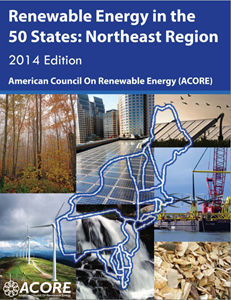Eleven Northeastern states added more than 800 MW of new,
renewable energy capacity in 2013.
The Northeast Region Report, the first portion of the
American Council On Renewable Energy's (ACORE)
7th annual Renewable
Energy in the 50 States report, was released today. The first in a
four-part series, this portion focuses on the renewable energy sector in the
eleven Northeastern states plus the District of Columbia (ME, NH, VT, MA, RI,
CT, NY, NJ, PA, DE, MD, DC), reviewing activity from 2013 to present. The
report is a review of state energy policies and programs, investment, and
market openness as they relate to the current state of renewable energy and its
potential for further growth.
"The Northeast Region has helped lead the reduction of
carbon dioxide emissions in the U.S. over the past decade, driven by the
Regional Greenhouse Gas Initiative (RGGI). RGGI has facilitated significant
reductions in carbon dioxide and other emissions in participating states since
it launched, while electricity prices declined," said Michael Brower,
ACORE's President and CEO. "This success of RGGI heralds the promise of
positive results from the U.S. Environmental Protection Agency's new proposed
Clean Power Plan rule, which will encourage the broader adoption of renewable
energy in the Northeast to achieve the state-by-state CO2 emission reduction
targets."
The region added more than 800 MW of new, renewable energy
capacity in 2013, mostly from solar power installations, with nearly $1 billion
in asset finance, venture capital and private equity investment. Many
states—notably New York and Massachusetts—maintained their renewable energy
policy leadership, incentivizing even greater private sector investment in the
industry. And while states across the U.S. have begun considering whether to
limit or repeal their net energy metering policies, Vermont quadrupled its net
metering cap in early 2014 with significant bipartisan support.
"With high electricity prices, a reliance on imported
energy, and ongoing retirements of fossil-fueled power plants, the Northeast
has strong incentives to develop local, renewable sources of energy,"
explained Lesley Hunter, ACORE's Research and Program Manager and lead author
of the report. "To meet 21st century energy needs, Northeastern states
need to assess and utilize all their renewable resource options, whether for
centralized or distributed power generation, transportation fuels, or thermal
energy, especially as technologies are becoming more cost-effective and widely
adopted."
Renewable Energy in the 50 States: Northeast Region provides
an executive summary for each state on the status of renewable energy
implementation at the state-level. Compiling financial, renewable energy
resource potentials, and market and policy information in an easily-accessed,
online format, the report is intended to be an executive summary for all who
are interested in the highlights of each renewable energy sector in the states.
Investment information in this report was provided by Bloomberg New Energy
Finance.
ACORE's 2014 Renewable Energy in the 50 States:
Northeastern Region can be viewed here.


No comments:
Post a Comment